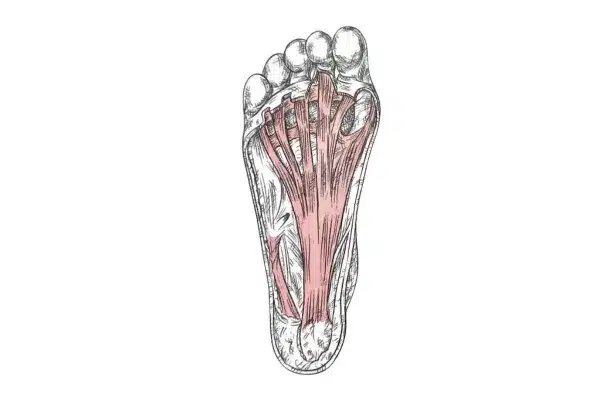Imagine waking each morning to a stabbing pain at your foot’s underside, heralding the first steps of the day with discomfort.
This common affliction arises from the inflammation of a band-like tissue—the ‘plantar fascia’—anchoring the toes to the heel and providing arch support, critical for daily activities and mobility.
Introducing the Plantar Fascia.
Defining Plantar Fascia
The plantar fascia is a thick robust, fibrous connective tissue spanning the base of the foot, essentially it connects the heel of the foot to the toes. It serves as an integral structural component, supporting the foot’s arch and absorbing the pressure and impact of each step taken.
As the foundation of foot biomechanics, this ligament-like band pronouncedly shapes our ability to walk, run, and leap, transferring forces seamlessly from the forefoot to the heel. Overuse or stress can lead to inflammation or plantar fasciitis, rendering simple activities challenging.
An understanding of the role and significance of this structure is essential for maintaining optimal foot health and managing potential disorders effectively.
Core Structure and Function
The plantar fascia, a sturdy fibrous band, underpins the foot’s anatomy, fostering arch stability and enabling dynamic movements. It’s crucial for the dispersal of mechanical forces during locomotion.
Embedded within the foot’s sole, this collagenous structure acts as a “biological spring”. Its tension adjusts to the stresses of walking, running, or standing, thereby maintaining arch integrity and contributing to foot biomechanics.
The plantar fascia can withstand the weight of a small car every single day, evidencing remarkable tensility and strength.
Operating beneath the skin: the fascia’s tautness, akin to a bowstring, adjusts correspondingly with our movements. It helps in attenuating shock (from ground impacts), conserving energy during ambulation, and providing a stable platform for the propulsion of our gait. Its performance is paramount to daily function and comfort.
Plantar Fascia’s Role in Movement
The plantar fascia’s integral role begins with supporting the foot’s arch, essential for bearing weight and enabling motion. In walking, it stretches to absorb impact, then recoils, propelling the foot forward.
This cyclical stretching and recoiling act as a critical energy saver during movement.
Engagement of the plantar fascia occurs with each step, functioning as a passive mechanism (without muscle contractions) aiding movement.
As the body advances over the foot, the plantar fascia tightens, creating a stiff lever for efficient push-off, essential for gait propulsion and agility.
This passive kinetic process is facilitated by the Windlass mechanism, whereby as the toes extend, tension increases in the plantar fascia, supporting the body weight and enabling the transition from foot-flat to toe-off.
Consequently, any disruption to the plantar fascia’s proper function can greatly affect an individual’s mobility. Minute alterations in its biomechanics may lead to significant gait disturbances and discomfort.
Common Plantar Fascia Issues
The plantar fascia is susceptible to various injuries and conditions that can cause significant discomfort and impair mobility. Plantar fasciitis is the most common ailment, characterized by sharp, stabbing pain near the heel, often most intense with the first steps in the morning or after periods of rest. Heel bone spurs, bony growths on the heel bone, can sometimes develop in conjunction with plantar fasciitis and contribute to pain. Less frequently, the plantar fascia may sustain a tear or rupture, especially in instances of acute trauma or excessive stretching. Chronic overuse or being overweight can also lead to plantar fascia stress syndrome, presenting as a diffuse pain along the arch of the foot. Proper diagnosis and management of these conditions are imperative for restoring function and reducing symptoms.
Symptoms of Plantar Fasciitis
The hallmark symptom of plantar fasciitis is a sharp, stabbing pain in the heel. It frequently manifests upon taking the first steps after awakening or long periods of sitting, with pain usually diminishing as the foot limbers up over time.
Stiffness and irritation at the heel may also be observed. These symptoms can significantly hinder daily activities, especially those that require standing or walking for extended periods.
Patients may describe a sensation akin to stepping on a sharp object when they place weight on their heel. This discomfort can radiate forward along the arch of the foot, exacerbating the debilitating nature of this condition.
Further, individuals suffering from plantar fasciitis often report increased pain after exercise, not during the activity. This post-exertional discomfort is typically worse following periods of rest. In addition to pain on the bottom of the heel, some experience swelling, redness, and heat in the affected area, indicating an inflammatory response due to overuse or injury to the plantar fascia.
What to do if you have damaged your Plantar Fascia?
At Foot Focus Plantar Fasciitis is one of the most common conditions we treat. There can be many difference causes and of course plenty of treatment options. The best thing a patient can do is come in for a full assessment first, so we can establish the root cause and design are treatment plan to help you recover and return to the activity you love.
If you are experiencing any of the issues mentioned in the above article, please give us a call on 015563662 and we’ll help you in any way possible.

